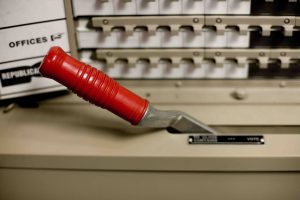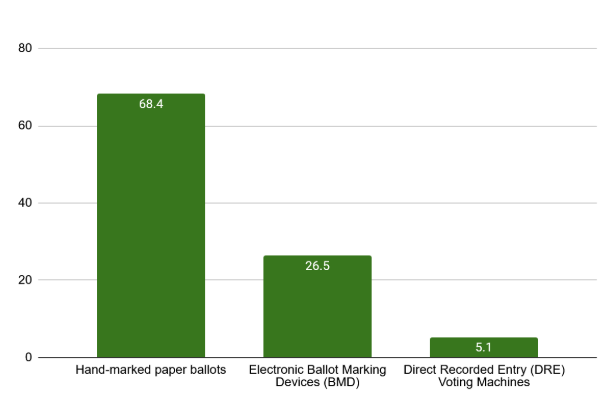6.2 Voting Technologies

As the Australian ballot began to proliferate in North America, some voters harboured suspicions that election officials could spoil ballots by ripping or damaging them. To safeguard the integrity of the vote, mechanical technologies began to emerge. By the 1890s, some American elections used voting machines with mechanical levers for voters to cast their votes (Mayton and Reno, 2021).
Over time, mechanical voting aids such as punch cards and levers had fallen out of favour. Equipment breakdowns and maintenance costs negated any cost savings, and the potential for corruption remained.
Contemporary Voting Practices
Currently, the most common form of voting involves manual ballot marking with a pen, pencil, or marker. Over 200 countries use some form of manual ballot marking (ACE Electoral Knowledge Network, n.d.-a). Alternatively, voters could use a piece of technology, such as a lever, punch card, or electronic Ballot Marking Device (BMD). American elections offer an interesting cross-section of technologies used for casting votes. The decentralized nature of electoral management means that different countries may adopt their own practices and technologies.

Manual Paper Ballots
Almost 70% of American voters live in jurisdictions that use hand-marked paper ballots (Verified Voting, n.d.). Despite the potential time savings associated with voting machines, manual voting remains popular because “paper ballots marked by hand create a tangible, tamper-evident and auditable record of voter selections” (Verified Voting, n.d., para. 1). The counting procedures may vary, with some counting performed manually, and others using optical scan technology, but paper ballots continue to be the most common method for casting votes.
Electronic Ballot Marking Devices (BMD)
An electronic BMD uses a computer interface to give voters an “electronic presentation of a ballot” (Ballotpedia, 2025b). With a BMD, the vote is only recorded and displayed for the user – it is not stored on the device. The video below was created by election officials in Los Angeles County to introduce voters to their new Ballot Marking Device machines.
This video outlines how to use the new ballot marking device, or Electronic Ballot Marking Devices.
“How to vote on the NEW Ballot Marking Device” by lacountyrrcc [1:35] is licensed under the Standard YouTube License. Music Only.
Direct Recording Electronic (DRE) Systems
After the controversy created by Palm Beach County’s butterfly ballot during the 2000 Presidential election, Congress passed the Help America Vote Act, which, among other things, required that states update election technology (EAC, n.d.). Many states chose to purchase Direct Recording Electronic (DRE) systems, more commonly known as voting machines. DRE machines will typically use a touchscreen to record votes, and the voting record will be stored on the machine’s hard drive or data cartridge (Ballotpedia, 2025b).
Dominion Voting Settlement
To ensure the integrity of the voting process, many DRE systems produce a Voter-Verifiable Paper Audit Trail (VVPAT), which is similar to a paper receipt (Ballotpedia, 2025). The receipt may not have any meaningful information for voters, but it may have a barcode, QR code, or other identifier that can be used for recounts.

